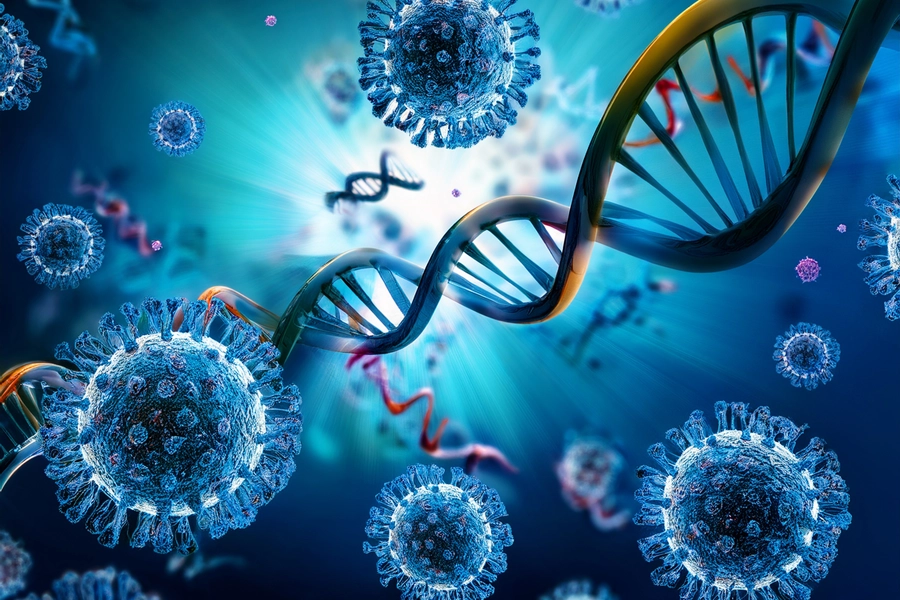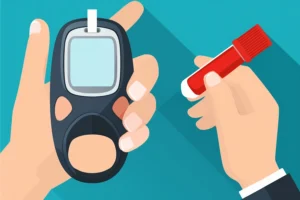Despite decades of global progress, HIV/AIDS remains one of the most pressing public health challenges of our time. While there is still no definitive cure for HIV, major advancements in treatment and care have transformed it from a life-threatening illness into a manageable chronic condition. Today, with early diagnosis and access to antiretroviral therapy, most individuals living with HIV can expect to live long, healthy lives without progressing to AIDS.
In this article, we explore the symptoms, causes, transmission, risk factors and complications of HIV/AIDS, along with its underlying pathophysiology. Raising awareness about HIV/AIDS is more important than ever, not only to combat stigma but also to empower individuals with accurate information and timely care.
Through this article, Medosis Health aims to inform, educate and encourage early prevention and support for all. Because understanding the virus is the first step in overcoming the fear.
What is HIV and its Types?
HIV (Human Immunodeficiency Virus) is a virus that attacks the body’s immune system, specifically the CD4 cells (T cells), which play a crucial role in defending against infections. Over time, if left untreated, HIV can weaken the immune system to the point where the body becomes vulnerable to opportunistic infections and certain cancers, leading to Acquired Immunodeficiency Syndrome (AIDS). It’s important to note that while there is no cure for HIV, it is a manageable condition with proper treatment, allowing individuals to live long and healthy lives.1
Types of HIV:
There are two main types of HIV:2
1. HIV-1: This is the most common and widespread type of HIV, responsible for the majority of global HIV infections. It is highly infectious and is found all over the world.
2. HIV-2: Less common, HIV-2 is primarily found in West Africa but can also spread to other parts of the world. While HIV-2 generally progresses more slowly than HIV-1, it still leads to AIDS if not treated.
Both types of HIV attack the immune system in similar ways, but their genetic makeup and the regions they affect vary.
What is AIDS?
Acquired Immunodeficiency Syndrome (AIDS) is the most advanced stage of infection caused by the Human Immunodeficiency Virus (HIV).3,4 It represents a critical breakdown of the immune system, where the body can no longer effectively fight off infections and certain cancers.
AIDS occurs after years of living with untreated or poorly managed HIV. As HIV progresses, it gradually destroys CD4 cells, a type of white blood cell essential for immune defense. When the CD4 count drops below 200 cells per cubic millimeter of blood (normal is between 500 and 1,600 cells/mm³), the immune system becomes severely weakened. At this point, the person is said to have developed AIDS.1
Additionally, regardless of the CD4 count, a person is considered to have AIDS if they develop one or more opportunistic infections, infections that occur more frequently and are more severe in individuals with weakened immune systems. These can include pneumonia, tuberculosis, certain types of cancers (like Kaposi’s sarcoma) and fungal infections.1
Key Characteristics of AIDS:
◦ Severely weakened immune system
◦ CD4 count below 200 cells/mm³
◦ Presence of opportunistic infections or AIDS-related illnesses
◦ Increased risk of life-threatening infections and complications
Without treatment, AIDS is fatal. However, with timely and consistent antiretroviral therapy (ART), the progression of HIV can be halted or significantly slowed, preventing the development of AIDS. Many people living with HIV who start treatment early and stay adherent never reach this advanced stage.
HIV Life Cycle
The HIV life cycle is a complex process involving multiple steps that allow the virus to invade host cells, replicate and spread throughout the body.5
1. Attachment and Entry: The virus begins by binding its gp120 glycoprotein to the CD4 receptor on the surface of T-helper cells. This triggers conformational changes that allow gp120 to bind a co-receptor (CCR5 or CXCR4), activating gp41, which fuses the viral and host cell membranes, allowing viral entry.
2. Capsid Uncoating and Reverse Transcription: Once inside, the viral capsid is dismantled, and the reverse transcriptase enzyme converts the virus’s RNA genome into DNA. This step lacks proofreading, often resulting in mutations or quasispecies.
3. Integration: The newly formed proviral DNA is transported into the nucleus with the help of the pre-integration complex (comprising viral proteins like integrase, Vpr, and p17), and integrated into the host genome by the viral integrase enzyme.
4. ranscription and Translation: The host cell machinery begins to transcribe and translate viral genes. This process is regulated by cellular and viral factors, including Tat and Rev proteins, which enhance transcription and manage mRNA transport and splicing.
5. Assembly and Budding: New viral proteins and RNA are assembled at the cell membrane. Vif (Viral infectivity factor) and Vpu (Viral protein U) assist in protecting viral components from host antiviral factors like APOBEC3G and tetherin, respectively.
6. Maturation and Release: The virus buds from the host cell, and viral protease cleaves precursor proteins (Gag and Gag-Pol), forming mature, infectious particles. In the absence of treatment, HIV continuously replicates, infecting more CD4+ T cells and creating a viral reservoir, making it harder to eliminate the virus completely. Each step of the HIV life cycle is a target for antiretroviral therapy (ART).
Physiopathogenesis of HIV
HIV infection progresses through complex immunological disruptions, driving disease severity and comorbidities. Key mechanisms include:5
1. CD4+ T Cell Depletion: HIV targets and destroys CD4+ T lymphocytes, critical cells for immune defense through pyroptosis, apoptosis, and sequestration. Activated and memory CD4+ cells, particularly those expressing CCR5, are highly vulnerable. Infected cells either die, produce new viruses or enter latent reservoirs. These mechanisms are mediated by caspase-dependent pyroptosis, p53 activation and Casp8p41-induced apoptosis.
2. Immune Activation and Chronic Inflammation: Persistent immune activation is a hallmark of HIV, driven by heightened cytokine levels (IL-6, TNF-α, IL-10) and ongoing T cell apoptosis. This inflammation contributes to comorbidities like cardiovascular diseases and cancers. Markers such as sCD163 and CD38+HLA-DR+ T cells correlate with disease progression, while double-negative T cells (CD3+CD4−CD8−) may regulate activation through IL-10 and TGF-β.
3. Gut-Associated Lymphoid Tissue (GALT) Depletion: The GALT, which houses ~50% of the body’s lymphoid tissue, is rapidly affected by HIV, particularly through the destruction of Th17 cells that maintain gut integrity. This leads to bacterial translocation and chronic immune activation. Markers like sCD14 and LPS indicate this process and ART can reduce these markers and partially restore immune function, especially when started early.
4. Metabolic Alterations: HIV induces significant metabolic disruptions:
◦ Oxidative stress from elevated ROS (Reactive Oxygen Species), damages cells and fuels inflammation.
◦ Impaired antioxidant defense due to reduced enzymes like glutathione and catalase.
◦ Altered tryptophan metabolism, driven by IDO-1 (Indoleamine 2,3-dioxygenase 1) induction, links to disease progression.
◦ Glucose metabolism dysregulation, with overactive glycolysis in CD4+ T cells and impaired glucose uptake in macrophages, exacerbates immune dysfunction.
5. Immune Response to HIV:
◦ Innate Immunity: NK cells, macrophages and dendritic cells are the first responders. Excessive activation leads to increased viral replication and CD4+ depletion. Galectins, especially Gal-9, regulate immune responses and contribute to viral persistence.
◦ Adaptive Immunity:
-Humoral Response: Initially non-neutralizing antibodies are produced against HIV proteins. The high variability of HIV makes it challenging to develop broadly neutralizing antibodies.
-Cellular Response: CD8+ T cells are crucial in controlling early viremia. Elite controllers demonstrate strong CD4+ and multifunctional CD8+ responses, though CD8+ dysfunction over time contributes to disease progression.
6. Viral Escape Mechanism: HIV’s high mutation rate, especially in the Envelope region, allows the virus to rapidly escape immune responses, including neutralizing antibodies and T cell-mediated immunity, contributing to persistent infection.
This combination of immune dysregulation, metabolic alterations and viral escape mechanisms underpins the complexity of HIV pathogenesis and the challenges in treatment and vaccine development.
HIV/AIDS Transmission
HIV (Human Immunodeficiency Virus) is transmitted primarily through the exchange of certain body fluids from an infected person to another. These fluids include blood, semen, vaginal secretions, breast milk and rectal fluids. Transmission can also occur from an HIV-positive mother to her child during pregnancy, childbirth or breastfeeding known as perinatal transmission. HIV is not spread through casual contact such as hugging, kissing, shaking hands or sharing food or water. Below, we break down the common modes of transmission:3,6
1. Sexual Transmission
◦ Anal Sex: This is one of the most efficient ways HIV is transmitted. During anal sex, either partner can contract the virus, but the bottom (the person receiving penetration) is at higher risk than the top. HIV can enter through the rectal lining, the urethra at the tip of the penis, foreskin or any cuts or sores on the penis. The risk is elevated in individuals with unprotected sex or inconsistent condom use.
◦ Vaginal Sex: HIV can also be transmitted during vaginal intercourse. Either partner can contract the virus, but HIV can enter the body through the vaginal lining or cervix. Semen, vaginal fluids and blood (especially during menstruation) can carry the virus, and transmission can occur through the urethra or broken skin on the penis.
2. Injection Drug Use
Sharing needles or drug injection equipment (such as syringes or “cookers”) is a significant route of HIV transmission. The shared equipment may carry infected blood, which directly enters the bloodstream, leading to HIV transmission. People who inject drugs may also engage in high-risk sexual behaviors, further increasing their chances of contracting HIV.
3. Perinatal Transmission (Mother-to-Child)
HIV can be passed from a mother to her baby during pregnancy, childbirth, or breastfeeding. This is particularly common in regions with less access to HIV treatment for pregnant women. However, with early access to antiretroviral therapy (ART), the risk of transmitting HIV during pregnancy, delivery or breastfeeding can be significantly reduced.
Signs and Symptoms of HIV
HIV symptoms vary depending on the stage of infection. Many individuals remain unaware of their infection, especially early on, even when the virus is most transmissible.3,5,7
1. Incubation Period
◦ Timeframe: 1 to 3 weeks after exposure (average ~14 days)
◦ What happens: HIV rapidly replicates in the body.
◦ Symptoms: Typically asymptomatic. If present, early signs appear around day 14.
2. Acute HIV Infection (Primary Stage)
Usually Occurs 2–4 weeks after exposure; symptoms may last 1–2 weeks.
a. Common Symptoms (Flu-like):
◦ Fever (often high, persistent, with night sweats)
◦ Headache
◦ Fatigue (Asthenia): marked and may require bed rest
◦ Sore throat
◦ Rash: appears 24–48 hrs after fever onset; often on face and trunk, includes papules, macules, or hives; may involve palms, soles or cause alopecia
◦ Swollen lymph nodes: cervical, axillary, occipital (may persist long-term)
◦ Muscle and joint pain
◦ Oral/genital ulcers
◦ Gastrointestinal issues: nausea, vomiting, diarrhea
b. Neurological Involvement (in up to 20%):
◦ Encephalitis (esp. limbic system)
◦ Peripheral neuropathy
◦ Guillain-Barré Syndrome
◦ Cognitive issues, depression, psychosis
◦ MRI may show signs of glial inflammation and neuronal damage
c. Biological Mechanism:
◦ HIV invades CNS early, crossing the blood-brain barrier
◦ Causes immune activation, glial toxicity and inflammation
2. Clinical Latency Stage (Chronic HIV) This stage may last for years (especially with ART).
Symptoms:
◦ Often asymptomatic
◦ Persistent lymphadenopathy
◦ Ongoing viral replication and slow CD4+ cell decline
3. Symptomatic HIV Infection As immunity weakens, more prominent symptoms appear:
◦ Weight loss
◦ Persistent fever
◦ Chronic diarrhea
◦ Cough
◦ Fatigue
4. AIDS (Acquired Immunodeficiency Syndrome)
Advanced HIV stage with CD4 <200 cells/μL or opportunistic infections.
Severe Illnesses/Complications:
◦ Tuberculosis (TB)
◦ Cryptococcal meningitis
◦ Pneumocystis jiroveci pneumonia
◦ Candidiasis (oral/esophageal)
◦ Severe bacterial infections
◦ Cancers: Kaposi’s sarcoma, non-Hodgkin’s lymphoma
◦ Worsening of co-infections: hepatitis B, C, mpox
Coinfections in Acute HIV (common when CD4 drops rapidly):
◦ Herpes simplex/zoster
◦ Oral/esophageal candidiasis
◦ Tuberculosis
◦ Toxoplasmosis
◦ Pneumocystis jiroveci
◦ Cryptosporidiosis
Mental Health Impact:
◦ Depression: Up to 50% of people with HIV
◦ Severe depression/psychosis in advanced stages
◦ Brain inflammation due to HIV encephalitis may trigger psychiatric symptoms
Risk Factors for HIV Infection
Understanding the risk factors for HIV is critical for prevention and targeted interventions. These factors can be behavioral, biological, social and structural, influencing the likelihood of transmission and acquisition.3,6,8,9
1. Viral Load
◦ The amount of HIV in the blood of an infected person.
◦ A higher viral load significantly increases the risk of HIV transmission.
◦ Peak Risk: During the acute phase (2–4 weeks post-infection), the viral load is highest, even before symptoms appear.
◦ Prevention: Antiretroviral therapy (ART) can reduce the viral load to undetectable levels, effectively preventing transmission (“Undetectable = Untransmittable”).
2. Co-existing Sexually Transmitted Infections (STIs)
◦ Examples: Syphilis, herpes, chlamydia, gonorrhea, bacterial vaginosis.
◦ STIs cause inflammation and breaks in the genital mucosa, making it easier for HIV to enter the body.
◦ Action: Regular STI screening and timely treatment can reduce this risk.
3. Unprotected Sexual Activity
◦ Anal or vaginal sex without a condom remains a leading cause of HIV transmission.
◦ Multiple sexual partners and inconsistent condom use further elevate the risk.
◦ Transactional sex, including sex work, is also a high-risk factor.
4. Drug and Alcohol Use
◦ Behavioral Risk: Impaired judgment and decision-making can lead to risky sexual practices.
◦ Injection Drug Use: Sharing needles, syringes or drug solutions can transmit HIV directly.
◦ Prevention Tip: Carry protection and use clean injecting equipment if needed.
5. Unsafe Medical Practices
◦ Contaminated needles or surgical instruments.
◦ Inadequately screened blood transfusions.
◦ Unsterile cosmetic procedures like tattooing or body piercings.
Note: These are rare in settings with proper infection control and regulation.
6. Occupational Exposure
◦ Healthcare Workers: Accidental needle-stick injuries and exposure to infected fluids are potential risks.
◦ Prevention: Standard precautions and post-exposure prophylaxis (PEP) help minimize risks.
7. Maternal-to-Child Transmission
◦ Timing: Can occur during pregnancy, childbirth or breastfeeding.
◦ Prevention: ART during pregnancy and safe feeding practices can significantly reduce transmission.
8. Social and Demographic Factors
◦ Gender: Women, especially in sub-Saharan Africa, are disproportionately affected.
◦ Age: Adolescents and young adults are at increased risk due to early sexual debut and lack of education.
◦ Poverty and Conflict: Increase vulnerability through limited healthcare access, sexual violence, and displacement.
9. Rare Transmission Routes
◦ Oral Sex: Risk increases with bleeding gums or STIs.
◦ Deep Open-Mouth Kissing: Extremely rare; only possible if both partners have open sores or bleeding gums.
◦ Biting or Pre-chewed Food: Possible only with blood-to-blood contact or exposure.
◦ Tattoos/Piercings: Risk only if tools are contaminated.
10. High-Risk Groups
◦ Female sex workers
◦ Men who have sex with men
◦ People who inject drugs (PWID)
◦ Prisoners
◦ Uniformed service members
◦ Transgender individuals
These groups often face stigma, discrimination and limited access to healthcare.
Conclusion
Understanding how HIV works, its transmission methods and its impact on the body is essential in combating misinformation and reducing stigma. With the advent of antiretroviral therapy (ART), HIV has evolved from a fatal disease into a manageable chronic condition, allowing individuals to lead long, healthy lives. However, prevention, early diagnosis and education remain our most powerful tools in the fight against HIV/AIDS.
At Medosis Health, we believe that informed minds lead to empowered lives. By spreading awareness, fostering compassion and supporting science-based care, we can work towards an AIDS-free generation. Know the virus, fight the fear and stand with those affected, not apart from them.
While HIV/AIDS continues to present significant challenges, the strides made in understanding the virus, improving treatments and enhancing prevention strategies have drastically improved the lives of those living with HIV. Through early diagnosis, consistent Antiretroviral therapy and breaking the stigma, HIV can be managed effectively. Let us continue raising awareness, promoting education and encouraging routine testing to give individuals the tools they need to prevent transmission and maintain their health. With knowledge, we can reduce fear, eliminate barriers and move toward a future where everyone can live free from the burden of this disease.
References
- gov. What Are HIV and AIDS? HIV.gov. Updated onJuly 26, 2023. Accessed on April23, 2025. Available from: https://www.hiv.gov/hiv-basics/overview/about-hiv-and-aids/what-are-hiv-and-aids
- Dilley KA, Ni N, Nikolaitchik OA, Chen J, Galli A, Hu WS. Determining the frequency and mechanisms of HIV-1 and HIV-2 RNA copackaging by single-virion analysis. J Virol. 2011 Oct;85(20):10499-508. https://pmc.ncbi.nlm.nih.gov/articles/PMC3187483/
- HIV and AIDS. WHO. Published on July22, 2024. Accessed on April23, 2025. Available from: https://www.who.int/news-room/fact-sheets/detail/hiv-aids
- NIH.gov. HIV and AIDS: The Basics. HIVinfo.NIH.gov. Last Reviewed on September 4, 2024. Accessed on April23, 2025. Available from: https://hivinfo.nih.gov/understanding-hiv/fact-sheets/hiv-and-aids-basics
- Omar Sued, Tomás M. Grosso. Chapter 17 – Pathophysiology of HIV and strategies to eliminate AIDS as a public health threat. Viral Infections and Antiviral Therapies;Academic Press. 2023:339-376. https://www.sciencedirect.com/science/article/pii/B9780323918145000234
- How HIV spreads. CDC. Published on November 25, 2024. Accessed on April23, 2025. Available from: https://www.cdc.gov/hiv/causes/index.html
- Boniphace et al. HIV/AIDS Clinical Manifestations and their Implication for Patient Clinical Staging in Resource Limited Settings in Tanzania. The Open AIDS Journal;2011; 5:9-16. https://openaidsjournal.com/contents/volumes/V5/TOAIDJ-5-9/TOAIDJ-5-9.pdf
- Kawuki, J., Kamara, K. & Sserwanja, Q. Prevalence of risk factors for human immunodeficiency virus among women of reproductive age in Sierra Leone: a 2019 nationwide survey. BMC Infect Di. 2022;22:60. https://bmcinfectdis.biomedcentral.com/articles/10.1186/s12879-022-07037-7#citeas
- Currie DW, West CA, Patel HK, et al. Risk Factors for Recent HIV Infections among Adults in 14 Countries in Africa Identified by Population-Based HIV Impact Assessment Surveys, 2015–2019. Emerging Infectious Diseases. 2023;29(11):2325-2334. https://wwwnc.cdc.gov/eid/article/29/11/23-0703_article#




